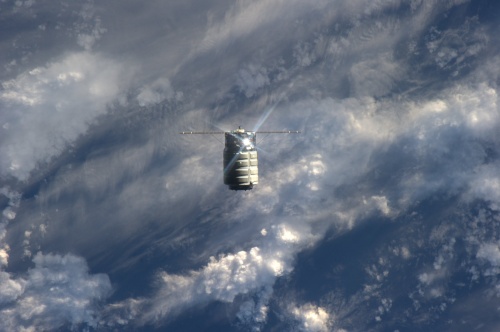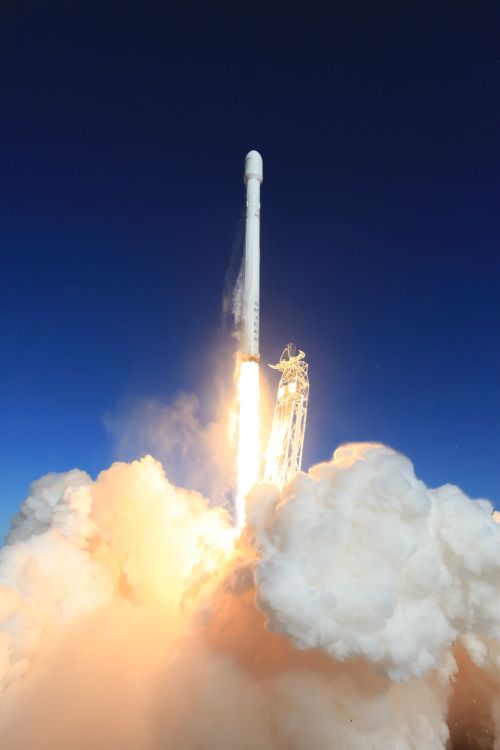One Thing Old, Two Things New; Proton Flies, OSC and SpaceX Triumph
It began with a historic berthing in LEO, and ended with the successful return to flight of a troubled booster steeped in anachronism. And right in the middle, the future emerged on a pillar of fire piercing a blue Pacific sky.
To begin at the ending, the oft troubled Proton booster returned to flight Sunday afternoon (U.S. time) with a successful International Launch Services flight out of the Baikonur Cosmodrome in Kazakhstan. Carrying the SES Astra 2-E satellite, the Proton-M booster, this time with motion sensors presumably installed correctly, overcame a flaming July 1st disaster, and successfully completed its complicated a 5 burn Briz upper stage insertion of the payload into the correct orbit.
The opening action in Sunday’s triple header took place in orbit, at the International Space Station. In successfully overcoming a software issue encountered on its initial approach to ISS and completing its first ever berthing to the orbiting outpost, with its Cygnus spacecraft, G. David Lowe, Orbital Sciences Corporation secured a remarkable achievement, and in doing so, completely validated the NASA/Commercial partnership model created in the Commercial Orbital Transportation Services Program. What stands out the most, is perhaps the fact that OSC is not SpaceX, designing, building and operating the Antares/Cygnus system in their own way, through a sub-contractor heavy arrangement which has a lot more in common with “Old Space” than “NewSpace.” As NASA’s Phil McCalister pointed out at the OSC press conference following the Antares booster’s maiden launch earlier this year, OSC’s success is a validation that even under the COTS rubric, there are many avenues to space.
If the OSC accomplishment did not send a sufficiently clear signal, based on comments made by Elon Musk in a telephone conference following the Falcon 9 v1.1’s maiden launch on Sunday, SpaceX is about to do so with video showing the booster’s first stage on its way back from launching the CASSIOPE mission. While the recovery effort was by no means a complete success, and the stage slammed hard into the Pacific after an insurmountable spinning motion threw fuel away from the pickup causing a flameout (shades of Falcon I, flight II) the fact that the company was able to bring it back into the atmosphere under control following an initial three engine deceleration burn, may go down as one of the red letter dates in space history. Quite simply, it would appear that contrary to almost everyone’s expectations, SpaceX, on the first try, was able to bring the booster shockingly close to where the Grasshopper’s flight envelope will be in a matter of months.
Everything did not go perfectly however, as an effort to re-start the second stage after the CASSIOPE satellite and three smaller payloads were deployed was cut short by a computer commanded abort. With second stage re-light being a critical capability for geostationary missions, according to Musk, the company will likely take a few additional weeks to thoroughly study the issue prior its next scheduled launch, that of the SES-8 Comsat headed to geostationary orbit with the new Falcon’s East Coast debut.
While another major, and equally critical milestone for SpaceX, it is not the SES launch, but the next NASA launch, CRS-3 which is already shaping up to be one of 2014’s most anticipated launch events. With the next two commercial launches pushing the Falcon 9’s limits, SpaceX is not going to attempt another recovery until the more lightly burdened NASA CRS-3 mission to low Earth orbit, and depending on how the schedule breaks down, that launch may be the first to be equipped with the retractable flight weight landing legs SpaceX showcased earlier this year. While SpaceX will not likely be in a position to attempt a ground landing on that flight, engineers believe the stabilizing effect of the legs will be help bring the rotation encountered on the CASSIOPE flight within manageable limits.
Looking just a bit further down the road, the SpaceX founder also revealed that the company is in discussions with the FAA and Air Force to designate a site at the eastern tip of Cape Canaveral for Falcon 9 first stage landings, one of which could lead to a re-flight as early as the end of next year.
One other point brought up in the teleconference involves SpaceX’s plans for KSC launch pad 39A. Assuming SpaceX gets past the objections raised by Blue Origin and secures a lease for the pad, plans call for the company to conduct all of its NASA launches to ISS out of that facility, while continuing to use SLC-40 for commercial and (eventually) military flights. Very significantly, it is these launches, sponsored by NASA and paid for by the taxpayers, which SpaceX is planning to use in its ongoing efforts to achieve first stage re-usability and drive down the costs to orbit.
Could there be a more powerful symbol for the potential inherent in the new approach to space operations demonstrated by both SpaceX and OSC, than a launch pad which saw tens of billions incinerated by a Shuttle system which succeeded in other ways, but failed miserably its initial and primary objective to lower costs, serve as the mid-wife for a new, and utterly transformative era of space transportation, and all at no additional cost to the taxpayer?




Wonderful job, Stewart. You need to remove the duplicate paragraphs that start about halfway down the column.
Best!
Bennett Dawson
Oops, and thank you!
I know it’s hard to proof one’s own work. Duplicate words are tough to see, duplicate paragraphs (due to a stutter when pasting) can be even more so when skimming for formatting. However, the last 7 paragraphs are duplicates from above.
Cheers and keep up the great writing!
Bennett Dawson
Thanks, I was sure I took that out yesterday after the first message, but rather obviously I didn’t sorry
I think Hemingway once said “write drunk, edit sober” Looks like I got that backwards